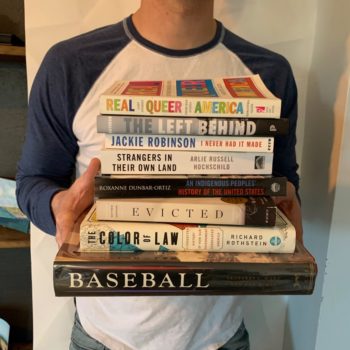Finishing 50 books is hard. But not impossible. Using the techniques below, I finished 63 books in 2020 and want to share some tips with you.
For starters, I don’t use the two most common techniques – speed reading and accountability mechanisms. Speed reading doesn’t make sense to me and the last thing I want is for reading to feel like work.
Instead, here’s how I think about reading more:
1) The simple math behind pages per day
The number of books you want to read this year is approximately equal to the number of pages you need to read per day. Want to read 20 books this year? That’s about 20 pages per day.
Books this year = pages per day
This rough calculation works because there are 365 days per year and books average about 300 pages for both fiction and nonfiction.
2) Read 2-3 books concurrently, spanning multiple topics
There is no virtue in maintaining a monogamous relationship with books. I always have two kinds of books going: one technical book which demands active and attentive reading, which I usually consume in the mornings and weekend days, the other a story or memoir that I read before bed.
Having multiple books going helps with:
- Technical books for daytime, casual reads before bed. I sleep poorly when reading technical books before bed and having a memoir helps my brain disengage and relax into a more restful state
- Matching mood for improved consistency. So much about reading is about consistency. You might think that consistency demands a singular focus. Wrong. Sometimes I’m not in the mood for a certain book and I just need to pick up another to achieve consistency, usually on a different topic.
- Progressing on slow reads. Reading 40 pages in one book can feel daunting, especially when it’s a slow read. But 20 pages in two books, that’s much easier. Same progress, different structure.
3) Use a highlighter for active reading
Active reading helps with retention and comprehension. And for me, highlighting is the most effective form of active reading because:
- Highlighting is more like data collection than data processing. Taking notes slows me down because I’m trying to process the text in real-time. Some people want that from reading, but I don’t. My brain doesn’t work like that. I process things in the background, so in real-time I just want to collect information quickly.
- Highlights are localized to the context. Taking notes in a separate notebook introduces a physical disconnect between note and context.
- Reviewing my highlights months after reading provides me with a feeling of achievement and retention that I otherwise would not have.
4) Find a consistently good recommendation source with with variety
I have two primary sources for book recommendations: the Bill Gates reading list and threads on Hacker News. Good recommendation sources cover a range of topics, so that you can better meet your goal of having 2-3 books going concurrently.
5) Binge on Saturday or Sunday morning
If you want to read a lot of books, you need long stretches of time of continuous reading. I suggest 3-5 hours on a Saturday or Sunday morning.
A good binge day for me will cover +150 pages, easily making up for any days I decide to take off.
6) Give yourself permission to bail early
Recently I started the Trusted Advisor which had 3.87 stars on Goodreads and 4.5 stars on Amazon, but I just couldn’t get into it. No problem.
I gave myself permission to bail after 15 pages, preventing a month of eating literary gruel. The opportunity cost of a bad, slow read is just too high – you can sometimes finish 3-4 good books with that time.
